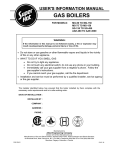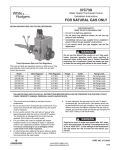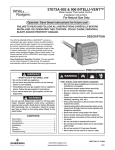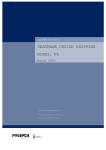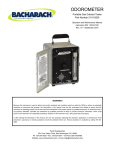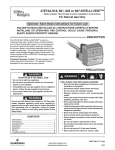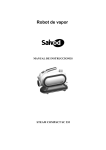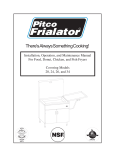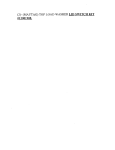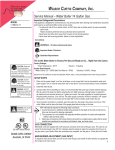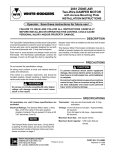Download White Rodgers 37C72U Thermostat User Manual
Transcript
37C72U Water Heater Thermostat Control Installation Instructions WHITE-RODGERS (Left-Hand Outlet Thread Model) FOR LP GAS ONLY RETAIN INSTRUCTIONS FOR FUTURE REFERENCE. • • • • FOR YOUR SAFETY “WHAT TO DO IF YOU SMELL GAS” Do not try to light any appliance. Do not touch any electrical switch; do not use any phone in your building. Immediately call your gas supplier from a neighbor’s phone. Follow the gas supplier’s instructions. If you cannot reach your gas supplier, call the fire department. ! WARNING PIL LIGH OT TI C CA ALDING OF SC RISK ITH SES W INCREA ATER ER W HOTT UTIO N: B LOW VER HOTY NG Do not use this LP Gas control on a Natural Gas water heater. Improper operation could occur, resulting in personal injury and/or death due to Carbon Monoxide poisoning, fire, or explosion. Check for proper gas type as listed on the rating plate affixed to the water heater. A NOTE Fixed Adjustment Main and Pilot Regulators The main and pilot gas regulators require no field service. They automatically control and maintain the outlet main and pilot burner gas pressure. This gas control is equipped with LEFT-HAND threads in the outlet for use on LP gas water heaters where the connection between the gas control and the main burner manifold are with LEFT-HAND threads. FAILURE TO READ AND FOLLOW ALL INSTRUCTIONS BEFORE INSTALLING OR OPERATING THIS CONTROL COULD CAUSE PROPERTY DAMAGE, PERSONAL INJURY AND/OR DEATH. 1. This control must be installed or serviced only by a professional. 2. Do not use force when moving the gas control knob. If you cannot turn the knob with hand pressure only, the control must be replaced. 3. Do not use the control if the knob will not “pop up” after being depressed while the knob is in the PILOT position. The mechanism is damaged and the control must be replaced. Shut off gas to the water heater. 4. For your safety, this control is supplied with tamper resistant screws. Do not attempt to repair or adjust the control. If you experience problems, replace the control immediately. Continuing to use a damaged control could result in fire and/or explosion. 5. LP gas is heavier than air. Leaking gas will settle near the ground and will tend to accumulate. 6. An odorant has been added to the gas to help you detect it. Before lighting, search for the odor of gas by sniffing at floor level around the water heater. WHITE-RODGERS DIVISION EMERSON ELECTRIC CO. 9797 REAVIS ROAD ST. LOUIS, MISSOURI 63123-5398 7. In some situations, the gas may lose its odor. To detect unodorized gas, you must have a gas detector which can be purchased from your gas company. If you do not have a detector and have the slightest suspicion that gas may be present, get out of the house and call the gas company. DO NOT RELY TOTALLY ON YOUR NOSE. 8. If any problems or questions are encountered about the safe use of LP gas, contact your local gas supplier. ! WARNING Scald burns occur in under one second with 160° water, which this thermostat will deliver if the temperature dial is set at “VERY HOT”. Lower settings of the temperature dial will reduce the risk of scald and will reduce your fuel bill. PART NO. 37-6093A Printed in U.S.A. 9912 INSTALLATION REPLACEMENT INFORMATION Gas supply pipe REMOVING OLD CONTROL 1. Shut off gas to water heater. 2. Shut off water at cold water inlet. 3. Connect hose to heater drain cock. Drain water to a nearby drain. Open a hot water faucet for faster draining. 4. Disconnect gas line at union (figure 1). Remove piping from old control. 5. Disconnect the: a. Thermocouple (left side). b. Pilot burner (small tube on the right side) c. Main burner (large tube in the middle). 6. Remove the control by turning it counterclockwise ). If needed, a short piece of 1/2” black iron pipe ( can be screwed into the control inlet to increase leverage. SPECIAL INSTALLATION NOTE Gas shut-off valve Union (metal-to-metal) Tee C CA LDING OF SCA H RISK SES WIT INCREA WATER HOTTER Drip leg (sediment trap) UTION : B LOW VER HOTY NG PIL LIGH OT TI A To pilot burner Pipe cap To main burner To thermocouple If replacing a Unitrol or Robertshaw control, install extension adaptor fitting provided into the outlet of the control. Figure 1. Typical gas connection INSTALLING NEW CONTROL All piping must comply with local and state ordinances or with the National Fuel Gas Code (ANSI Z223.1–NFPA 54), whichever applies. 4. Connect gas line. Use new black iron pipe that has been properly reamed. If old pipe is used, be sure it is clean and free from rust and scale. Use pipe joint compound on male threads only. (Use a pipe joint compound approved for natural gas service.) Do not use TEFLON tape. Do not apply compound to first two threads. 5. DO NOT use joint compound or tape on the union connection. 6. To fill the water heater with water: a. Close the water heater drain valve by turning the handle to the right (clockwise). The drain valve is on the lower front of the water heater. b. Open the cold water supply valve to the water heater. Dirt or contamination in the gas line can block the control from operating creating a risk of explosion, injury or death. To protect the control from dirt/contamination, a drip leg or sediment trap (see Figure 1) must be installed in the piping leading to the control. 1. Apply pipe joint compound to the male threads of control, leaving the first two or three threads clean. 2. Install control in tank. Turn clockwise ( ). Use a short piece of pipe to help in turning. Align the control so that burner and pilot tubes may be connected. NOTE This control is equipped with LEFT-HAND threads on the outlet of the control. Check the fitting on the burner assembly to make sure the threads are also the LEFT-HAND type. If the threads are not LEFT-HAND type, return the control to the dealer and obtain an LP gas control with RIGHT-HAND threads on the outlet. NOTE The cold water supply valve must be left open when the water heater is in use. c. To ensure complete filling of the tank, let air exit by opening the nearest hot water faucet. Allow water to run until a constant flow is obtained. This will let air out of the water heater and the piping. d. Check all new water piping for leaks. Repair as needed. 3. Make burner, pilot, and thermocouple connections. Do not use pipe joint compound or teflon tape. Thermocouple nut should be hand tightened and then turned an additional 1/4 turn with a small wrench. DO NOT OVERTIGHTEN. 2 d. Recheck for leaks. e. Rinse off soapy solution and wipe dry. ! CAUTION Never use this water heater unless it is completely filled with water. To prevent damage to the tank, the tank must be filled with water. Water must flow from the hot water faucet before turning ON gas to the water heater. ! WARNING DO NOT USE OPEN FLAME OR ANY KIND OF SPARK TO CHECK FOR LEAKS. Serious injury or death from fire or explosion could result. 7. Open gas shutoff valve. 8. BEFORE LIGHTING THE PILOT, CHECK THE GAS LINES FOR LEAKS: a. Use a soapy water solution. DO NOT test for gas leaks using a match or open flame. b. Brush the soapy water solution on all gas pipes, joints, and fittings. c. Check for bubbling soap. This means you have a leak. Turn OFF the gas and make the necessary repairs. 9. Affix the new Lighting Instruction label on the water heater to cover the existing label. NOTE The rating plate must be left visible for future reference. TO LIGHT APPLIANCE TEMPERATURE POINTER T P LIG ILO HT VE HOTRY G IN C CAUTION: B INCREASES WITH A HOTTER WATER LOW RISK OF SCALDING WATER TEMPERATURE DIAL HOT ON OFF 2. Turn gas control knob clockwise to “OFF”. OFF Figure 2. Gas Control Knob and Water Temperature Dial PIL O T NOTE Gas control knob must be depressed slightlyto turn from "PILOT" to "OFF". Do not use tools or excessive force. 3. Wait at least five (5) minutes to clear out any gas, and then smell around the appliance area. If you smell gas, STOP! Follow instructions “What to do if you smell gas” on the first page of this instruction sheet. If you do not detect gas, continue with the next step. 4. Remove inner and outer burner doors located on the water heater under gas control unit. 5. Find pilot - follow small metal tubes from gas control. The pilot is located near the main PILOT THERMOBURNER COUPLE burner. 3 ON 6. Turn gas control knob counterclockwise PIL O T to “PILOT”. 7. Depress control knob all the way and hold down. Immediately light the pilot with a match. Continue to hold knob down for approximately one (1) minute after pilot is lit. Release knob and it will pop back up. Pilot should remain lit. If pilot goes out, repeat steps 2, 3, 6 and 7. • If knob does not pop up when released, turn knob clockwise to “OFF”. STOP and immediately call your service technician or gas supplier. • If the pilot will not stay lit after several tries, turn gas control knob to “OFF” and call your service technician or gas supplier. 8. Replace inner and outer burner doors. 9. At arm's length away, turn gas control knob counterclockwise to the full “ON” PIL O T position. 10. Align the water temperature dial mark ( ) with the temperature pointer on the cover. This mark, indicative of approximately 120°F, is the preferred starting point. If hotter water is desired, see TEMPERATURE REGULATION on page 4. 11. Check for leaks at the pilot and main burner fittings on the gas control with the main burner firing. Use a soapy water solution. If a leak is detected, turn the gas supply off and make repairs. GAS CONTROL KNOB P IL O T ON OFF 1. Set control to lowest setting by turning the water tem) to the “PILOT LIGHTperature dial clockwise ( ING” position. DO NOT FORCE. TEMPERATURE REGULATION After the gas connections are made, water is in the heater and the pilot light is ignited, the control must be set to the desired water temperature. The recommended water temperature dial setting is at the arrow ( ). The water temperature out of the heater at this setting will be approximately 120°F. If you use hot water frequently and in short spurts, water temperature can occasionally exceed the temperature setting by up to 30°F because of the dynamics of the appliance. P IL O T TEMPERATURE POINTER T P LIG ILO HT VE HOTRY G IN C CAUTION: B INCREASES WITH ! WARNING The hotter the water the greater the risk of scald injury and the shorter the time to cause injury. SETTING APPROXIMATE TEMPERATURE (°F) APPROXIMATE TIME TO CAUSE INJURY ( ) 120° ±10° 5 Minutes A 130° ±10° 30 Seconds B 140° ±10° 5 Seconds C 150° ±10° 1.5 Second VERY HOT 160° ±10° Under 1 Second Be sure to protect babies and the infirm or others with impaired mobility who cannot get out of the hot water quickly. They are the people most commonly hurt in scald injuries and in need of lower temperature and other protection like supervision, point-of-use temperature control equipment or a system mixing valve. A point-ofuse valve or a system mixing valve can be obtained from your plumber. WATER TEMPERATURE DIAL A HOTTER WATER LOW RISK OF SCALDING To avoid scald injury, set the control at the lowest setting which will still deliver your needed hot water. HOT Figure 3. Water Temperature Dial The arrow ( ) setting is the safest and most economical. If you want hotter water, rotate the water temperature dial ) to a higher setting. Approximate counterclockwise ( water temperature delivered at the different settings is shown in the following table. ! WARNING Never allow small children to use a hot water tap, or to draw their own bath water. Never leave a child or impaired person unattended in a bathtub or shower. Scald burns can result. TO TURN OFF GAS TO APPLIANCE ON OFF Turn gas control knob clockwise to “PILOT”. PIL O T ON Turn gas control knob clockwise to “OFF”. OFF Set the control to lowest setting by turning water temperature dial clockwise ( ) to the “PILOT LIGHTING” position on dial (as shown in Figure 3). DO NOT FORCE. PIL O T NOTE Gas control knob must be depressed slightly. Do not use tools or excessive force. Review and leave these instructions with the consumer!




